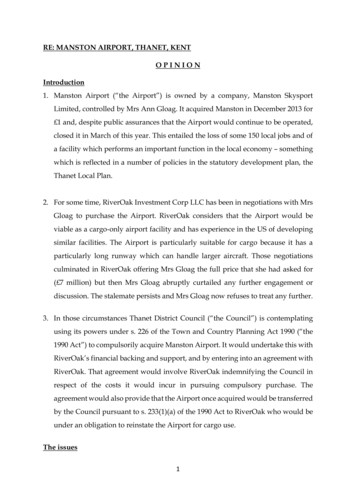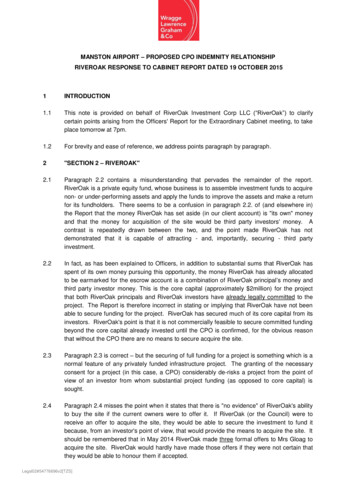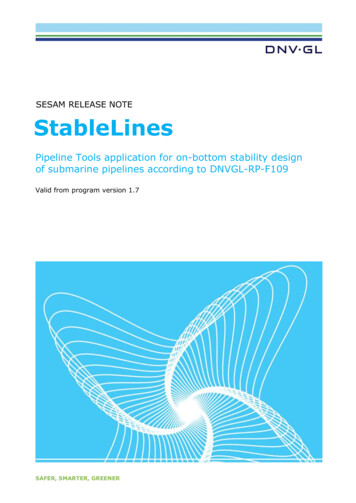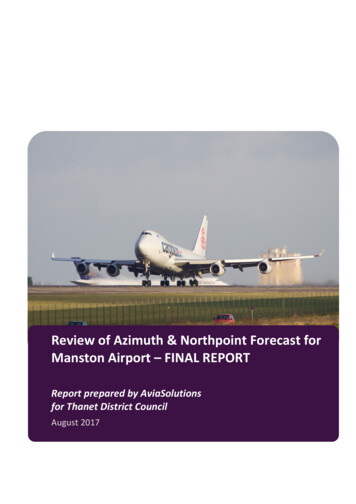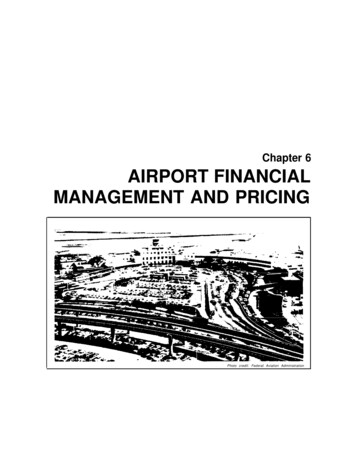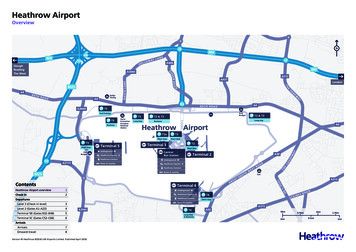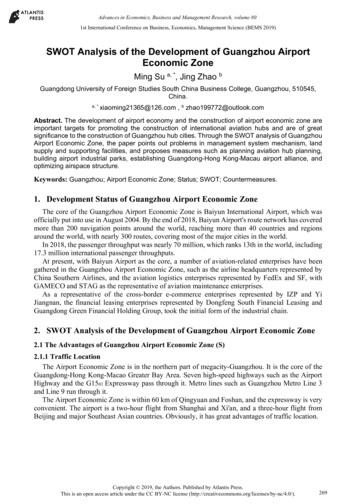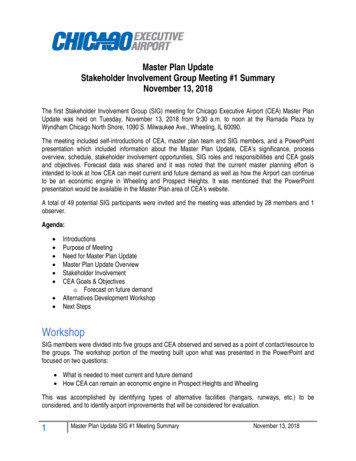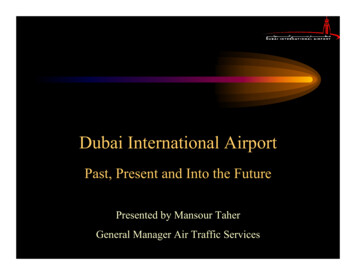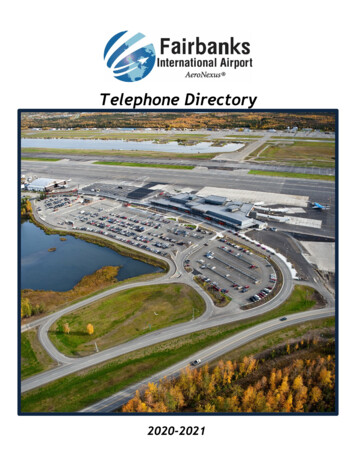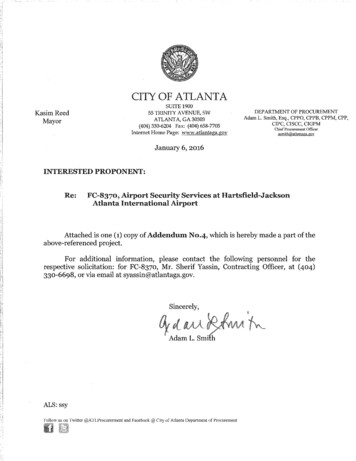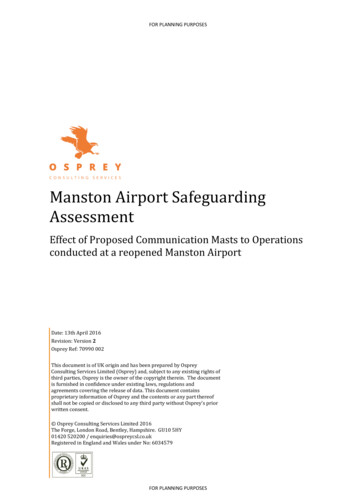
Transcription
FOR PLANNING PURPOSESManston Airport SafeguardingAssessmentEffect of Proposed Communication Masts to Operationsconducted at a reopened Manston AirportDate: 13th April 2016Revision: Version 2Osprey Ref: 70990 002This document is of UK origin and has been prepared by OspreyConsulting Services Limited (Osprey) and, subject to any existing rights ofthird parties, Osprey is the owner of the copyright therein. The documentis furnished in confidence under existing laws, regulations andagreements covering the release of data. This document containsproprietary information of Osprey and the contents or any part thereofshall not be copied or disclosed to any third party without Osprey’s priorwritten consent. Osprey Consulting Services Limited 2016The Forge, London Road, Bentley, Hampshire. GU10 5HY01420 520200 / enquiries@ospreycsl.co.ukRegistered in England and Wales under No: 6034579FOR PLANNING PURPOSES
FOR PLANNING PURPOSESDocument DetailsReferenceDescriptionDocument TitleManston Airport Safeguarding AssessmentEffect of Proposed Communication Masts to Operationsconducted at a reopened Manston AirportDocument Ref70990 002IssueVersion 2Date13th April 2016Client NameRiverOak Investment CorpClassificationFor Planning PurposesApproval LevelAuthorityAuthorOsprey CSLReviewerOsprey CSLApproverOsprey CSLManston Airport Safeguarding Assessment Document Details70990 002 Version 2FOR PLANNING PURPOSESii
FOR PLANNING PURPOSESExecutive SummaryRiveroak Investment Corp (RiverOak) is investing in the future use of Manston Airport(formally Kent International Airport) and has commissioned Osprey Consulting ServicesLimited (Osprey) to assess what the potential impact of two proposed mast developmentswould be if the airport were licensed and regulated in accordance with Civil Aviation Authority(CAA) and European Aviation Safety Agency (EASA) standards.As its purpose is to inform relevant Planning Authorities, this review focuses on the masts asphysical obstructions to aviation. It does not consider broader issues such as electromagneticinterference, lighting or impact on the wider aviation communities; these may also need to betaken into account when considering these proposals.As part of this assessment, the Obstacle Limitation Surfaces (OLS) for the airport wereestablished and assessed in relation to the proposed communications masts. It was found thatthe two masts would penetrate the Manston Airport Inner Horizontal Surface (IHS)(Richborough Power Station Mast (Vigilant)) and the Manston Airport Conical Surface (KingsEnd Farm (NLN) Mast). The extent of the breach created by each mast is significant; Ospreyassess that if Manston Airport were currently operational, safety concerns associated with sucha severe breach so close to the airport, would cause the airport operator to object to thedevelopments on the grounds of CAA Airport Safeguarding Regulations.Turning to arrival and departure procedures, the minimum vectoring altitude in the vicinity ofthe communication masts would have to be increased to 2,100 feet, (an increase of 600 feet)).This is to ensure the required vertical clearance between aircraft in receipt of an InstrumentFlight Rules (IFR) service from Air Traffic Control, and the top of the mast structures, ismaintained. This increase may also impact the design of any new Instrument Flight Procedures(IFPs) for the airport and may affect any decision on suitable holding heights. It would alsohave to be taken into account by controllers when vectoring aircraft in the vicinity of theairport. Whilst such changes would impact IFR operations at Manston Airport, Ospreyconsidered that such an impact could be managed successfully.For aircraft operating under Visual Flight Rules (VFR), the proposed communication mastsrepresent a much greater hazard. Aircraft operating in Manston’s southerly visual circuit wouldbe confronted by the masts at circuit height as they turned downwind. Aircraft are legallyobliged to avoid such obstructions by 500 ft laterally or vertically but they can be difficult to seefrom the air especially in marginal weather conditions and particularly whilst undertaking busyand critical stages of flight, such as an approach to land or immediately after departure. Topartially mitigate this risk, changes to the routing or altitude of the visual circuit could be madebut these would themselves introduce new, and potentially more severe, risks. Use of thenortherly circuit would reduce the risk to visual circuit operations but would concentrate thenoise footprint and other environmental effects over a populated area used for tourism andrecreation. Even if such measures were applied, the risk to VFR operations to the south of theairport cannot be managed, despite the application of mitigation measures (which may changebut not address the hazards). Osprey assess that if Manston Airport were currently operational,its operators would object to the mast developments on the grounds of their threat to the safetyof aircraft operating VFR to the south of the airport, particularly in the visual circuit.Manston Airport Safeguarding Assessment Executive Summary70990 002 Version 2FOR PLANNING PURPOSESiii
FOR PLANNING PURPOSESThe purpose of an Air Traffic Zone (ATZ) at Manston Airport would be to provide protection toaircraft departing, arriving or flying in the vicinity of the airport by ensuring that any aircraft inthe immediate vicinity is required to contact ATC. It is not intended to ensure terrain andobstacle clearance to either IFR or VFR operations (including the visual circuit); these arecovered under other regulations. Although the process outlined in CAP 724 takes into account arange of factors when considering whether an ATZ should be granted, it would not take intoaccount the Vigilant and NLN mast developments. However, while Osprey assess that, in theory,the proposed communication masts would have little impact on Manston Airport’s applicationfor an ATZ, in practice they would have such an operational impact on IFR procedures and sucha significant operational and safety impact on VFR procedures, that the case for establishment ofan ATZ would be undermined.In summary, the proposal to develop communication masts to the south of Manston Airportwould significantly infringe the CAAs OLS criteria, which are specifically established to ensuresafe operations in the vicinity of an airport. The severity of this infringement, which cannot befully mitigated, could undermine Manston Airports case for a CAA License and EASA approval.This, in turn, would have significant commercial implications as operators may not wish (or beable) to operate from an unlicensed or non-EASA compliant airport. While Osprey consider thatIFR procedures could be modified to accommodate the masts and Manston Airports case for anATZ is likely to be unaffected by them, the masts would represent a considerable flight safetyhazard to aircraft operating VFR to the south of the Airport and particularly in its southerlyvisual circuit. Mitigation measures would either introduce new risks or significantly increasenoise over the main built up areas of Margate, Broadstairs, Ramsgate, and Herne Bay; even then,the safety risk to VFR operations to the south of the airport would remain and could not bemitigated.Osprey therefore conclude that, if Manston Airport were currently operational, its Operatorswould object to the proposed mast developments on the following grounds:-The severity of their penetration of the Airports OLS.-The flight safety risk they would represent to aircraft operating VFR to the south of theairport, particularly those operating in its southerly visual circuit.Manston Airport Safeguarding Assessment Executive Summary70990 002 Version 2FOR PLANNING PURPOSESiv
FOR PLANNING PURPOSESTable of Contents1Introduction . 11.11.21.31.41.5Overview . 1Details of the Proposed Communication Masts . 1Background. 2Scope . 2Document Structure . 32The Communication Masts. 52.12.22.3Overview . 5Vigilant Mast. 6Kings Head Farm Mast . 63Control of Obstacles in the Vicinity of Aerodromes . 73.13.13.23.33.43.5Overview . 7OLS: Overview . 7Obstacle Limitation Surfaces . 8Restriction and Removal of Obstacles . 9Aerodrome Safeguarding – Obligations . 9Marking and Lighting of Obstacles – Obligations. 94Manston Airport Safeguarding . 114.14.24.34.44.5Overview . 11Obstacle Limitation Surfaces at Manston Airport. 11Inner Horizontal Surface (IHS) . 12Conical Surface . 12Conclusions . 145Manston Instrument Approach Procedures . 155.15.25.35.45.55.65.75.8Runways and Airspace . 15Air Traffic Control (ATC) Radar Operations at Manston . 16Instrument Flight Rule Procedures . 17Radar Vectored Approaches . 19Application of the RVA at Manston Airport . 20Communication Transmitters Fresnel Zone . 20Terrain/Obstacle Clearance Criteria . 20Conclusions . 226Manston Visual Circuit Procedures . 246.1Overview . 24Manston Airport Safeguarding Assessment Table of Contents70990 002 Version 2FOR PLANNING PURPOSESv
FOR PLANNING PURPOSES6.26.36.46.56.66.7Manston Visual Circuit Operations . 24Impact Created by the Communication Masts on Visual Circuit Operations . 25Aviation Objections . 26Visual Circling Operations . 26Search and Rescue Operations . 27Conclusions . 277Manston Airport - Airspace . 297.17.27.37.4Overview . 29Purpose of an ATZ . 29Application Process . 30Conclusions . 318Conclusions. 328.18.28.38.48.5Overview . 32OLS . 32Instrument Procedures/Radar Vectoring Area . 32Visual Circuit Operations . 32ATZ . 339References . 34A1CAA Approved Procedure Designer Report . 36A1.1A1.2A1.3A1.4A1.5A1.6A1.7A1.8Overview . 36Instrument Departure Procedures . 36Aircraft Holding Pattern . 37Visual Manoeuvring Procedures following an Instrument Approach . 37Aircraft Flying Visual Circuits . 37Other Airfield Examples . 38General Comments on OLS. 38Summary . 38A2Osprey Brief Résumés. 39A2.1Overview . 39Table of FiguresFigure 1 Location of the Vigilant Richborough Mast and the NLN Kings Head Farm Mast sitecentre. . 5Figure 2 Vigilant Richborough Mast Location . 6Figure 3 Illustration of the IHS and Conical Surfaces . 8Figure 4 Location of the Masts within Lateral Boundaries of Affected Manston OLS (not to scale). 13Figure 5 Illustration of the breach of the Manston OLS created by the two masts. . 14Figure 6 Existing tall structure to the South of Manston Airport . 16Figure 7 Manston IFP and the Location of the two Proposed Masts . 18Manston Airport Safeguarding Assessment Table of Contents70990 002 Version 2FOR PLANNING PURPOSESvi
FOR PLANNING PURPOSESFigure 8 Manston RVA as published when Manston was active . 19Figure 9 Manston RVA with inclusion of the highest altitude of the masts (not to scale) . 22Table of TablesTable 1 Calculation on Assessing Impact to the Manston RVA if the Masts are constructed. . 21Table 2 Table of References . 35Manston Airport Safeguarding Assessment Table of Contents70990 002 Version 2FOR PLANNING PURPOSESvii
FOR PLANNING PURPOSES1IntroductionThis section introduces the background, methodology and scope of theassessment.1.1OverviewRiveroak Investment Corp (RiverOak) is committed to the reopening of ManstonAirport (formerly Kent International Airport) and are in early discussions with thePlanning Inspectorate about submitting an application for a Development ConsentOrder (DCO) for what would be a Nationally Significant Infrastructure Project (NISP).RiverOak has commissioned Osprey Consulting Services Limited (Osprey) toundertake an assessment of the potential for two proposed communication masts toinfluence operations at Manston Airport were it reopened and licensed in accordancewith Civil Aviation Authority (CAA) and European Aviation Safety Agency (EASA)Regulations.The purpose of this review is to inform relevant Planning Authorities on the potentialaviation impact of both developments; as such it focuses on the masts
Riveroak Investment Corp (RiverOak) is committed to the reopening of Manston Airport (formerly Kent International Airport) and are in early discussions with the Planning Inspectorate about submitting an application for a Development Consent Order (DCO) for what would be a Nationally Significant Infrastructure Project (NISP).
